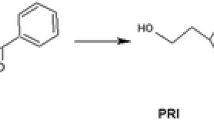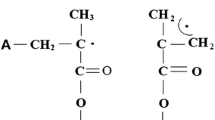Abstract
The propagating and allylic free radicals generated when polymerizing dimethacrylate resin-based materials used in dentistry are detected by electron spin resonance (ESR) spectroscopy as a nine-line spectrum. This study aimed to probe their post-polymerization reactivity with a novel methodology to quantify these radicals separately. X-band ESR spectra were recorded from a photo-cure dental resin composite (~ 20 days) and a dual-cure resin cement (~ 15 days). Spectra simulations were applied to separate and determinate the contribution from each radical to the ESR signal according to the method presented. The decay curves of the free radicals were then obtained to probe their post-polymerization reactivity as function of composition and initiation mode (photo-cure and self-cure). The allylic radical’s post-polymerization half-life time was approximately twice than that of the propagating radical, independently the composition and the activation mode, indicating that their relative reactivity does not depend of these parameters. The methodology presented for individual quantification of free radicals showed to be adequate to probe the kinetics of the free radicals generated and trapped in resin-based dental.








Similar content being viewed by others
References
Sideridou ID, Achilias DS (2005) Elution study of unreacted Bis-GMA, TEGDMA, UDMA, and Bis-EMA from light-cured dental resins and resin composites using HPLC. J Biomed Mater Res Part B Appl Biomater 74:617–626. https://doi.org/10.1002/jbm.b.30252
Leprince JG, Palin WM, Hadis MA et al (2013) Progress in dimethacrylate-based dental composite technology and curing efficiency. Dent Mater 29:139–156. https://doi.org/10.1016/j.dental.2012.11.005
Ferracane JL (2011) Resin composite—state of the art. Dent Mater 27:29–38. https://doi.org/10.1016/j.dental.2010.10.020
Sideridou I, Tserki V, Papanastasiou G (2002) Effect of chemical structure on degree of conversion in light-cured dimethacrylate-based dental resins. Biomaterials 23:1819–1829. https://doi.org/10.1016/s0142-9612(01)00308-8
Salomão FM, Vicentin BLS, Contreras EFR et al (2015) The influence of a translucent fiberglass post on the polymerization of dual cure resin cement analyzed by electron paramagnetic resonance. Mater Res 18:1023–1028. https://doi.org/10.1590/1516-1439.022115
Jakubiak J, Allonas X, Fouassier JP et al (2003) Camphorquinone-amines photoinitating systems for the initiation of free radical polymerization. Polymer (Guildf) 44:5219–5226. https://doi.org/10.1016/s0032-3861(03)00568-8
Ikemura K, Endo T (2010) A review of the development of radical photopolymerization initiators used for designing light-curing dental adhesives and resin composites. Dent Mater J 29:481–501. https://doi.org/10.4012/dmj.2009-137
Nie J, Andrzejewska E, Rabek JF et al (1999) Effect of peroxides and hydroperoxides on the camphorquinone-initiated photopolymerization. Macromol Chem Phys 200:1692–1701. https://doi.org/10.1002/(sici)1521-3935(19990701)200:7%3c1692:aid-macp1692%3e3.0.co;2-r
Teshima W, Nomura Y, Tanaka N et al (2003) ESR study of camphorquinone/amine photoinitiator systems using blue light-emitting diodes. Biomaterials 24:2097–2103. https://doi.org/10.1016/s0142-9612(02)00636-1
Kwon TY, Bagheri R, Kim YK et al (2012) Cure mechanisms in materials for use in esthetic dentistry. J Investig Clin Dent 3:3–16. https://doi.org/10.1111/j.2041-1626.2012.00114.x
Truffier-Boutry D, Gallez XA, Demoustier-Champagne S et al (2003) Identification of free radicals trapped in solid methacrylated resins. J Polym Sci Part A Polym Chem 41:1691–1699. https://doi.org/10.1002/pola.10692
Vicentin BLS, Salomão FM, Hoeppner MG, Di Mauro E (2016) Influence of geometrical configuration of a translucent fiberglass post on the polymerization of a dual cure resin cement analyzed by EPR spectroscopy. Appl Magn Reson 47:211–222. https://doi.org/10.1007/s00723-015-0740-x
Anseth KS, Anderson KJ, Bowman CN (1996) Radical concentrations, environments, and reactivities during crosslinking polymerizations. Macromol Chem Phys 197:833–848. https://doi.org/10.1002/macp.1996.021970306
Da Fontes AS, Vicentin BLS, Valezi DF et al (2014) A multifrequency (X-, Q-, and W-band) EPR and DFT study of a photopolymerizable dental resin. Appl Magn Reson 45:681–692. https://doi.org/10.1007/s00723-014-0546-2
Vicentin BLS, Netto AM, Blümich B, Di Mauro E (2016) Identification of free radicals generated by different curing modes in a dental resin cement. Appl Magn Reson 47:1003–1014. https://doi.org/10.1007/s00723-016-0803-7
Leprince JG, Lamblin G, Devaux J et al (2010) Irradiation modes’ impact on radical entrapment in photoactive resins. J Dent Res 89:1494–1498. https://doi.org/10.1177/0022034510384624
Bunce NJ (1987) Introduction to the interpretation of electron spin resonance spectra of organic radicals. J Chem Educ 64:907. https://doi.org/10.1021/ed064p907
Gerson F, Huber W (2003) Electron spin resonance spectroscopy of organic radicals, 1o edn. WILEY-VCH Verlag GmbH & Co., KGaA, Weinheim
Ottaviani MF, Fiorini A, Mason PN, Corvaja C (1992) Electron spin resonance studies of dental composites: effects of irradiation time, decay over time, pulverization, and temperature variations. Dent Mater 8:118–124. https://doi.org/10.1016/0109-5641(92)90066-l
Fontes ADS, Di Mauro E, Sano W et al (2009) Avaliação do comportamento de radicais livres e desempenho mecânico de compósitos restauradores dentais comerciais por Ressonância Paramagnética Eletrônica (RPE) combinada às análises convencionais. Polímeros 19:285–291. https://doi.org/10.1590/s0104-14282009000400007
Da Fontes AS, Sano W, Antonia LHD, Di Mauro E (2010) EPR in the characterization of the shade effect on translucence, remaining free radicals, and polymerization depth of commercially available resin composites. Appl Magn Reson 39:381–390. https://doi.org/10.1007/s00723-010-0172-6
Vicentin BLS, Netto AM, Dall’Antonia LH et al (2017) Real-time polymerization monitoring in a dual-cured resin cement by magnetic resonance. Polym Bull 74:5163–5179. https://doi.org/10.1007/s00289-017-2007-1
Lamblin G, Devaux J, Biebuyck J (2007) Electron spin resonance, a useful analytical technique for studying the kinetic decay of free radicals trapped in dental resin. Eur Cells Mater 13:2262
Leprince J, Lamblin G, Truffier-Boutry D et al (2009) Kinetic study of free radicals trapped in dental resins stored in different environments. Acta Biomater 5:2518–2524. https://doi.org/10.1016/j.actbio.2009.04.034
Truffier-Boutry D, Demoustier-Champagne S, Devaux J et al (2006) A physico-chemical explanation of the post-polymerization shrinkage in dental resins. Dent Mater 22:405–412. https://doi.org/10.1016/j.dental.2005.04.030
Fonseca R, Santos C, Adabo L (2004) The influence of chemical activation on hardness of dual-curing resin cements a influência da ativação química na dureza de cimentos resinosos duais. Braz Oral Res 18:228–232. https://doi.org/10.1590/S1806-83242004000300009
Arrais CAG, Kasaz ADC, Albino LGB et al (2010) Effect of curing mode on the hardness of dual-cured composite resin core build-up materials. Braz Oral Res 24:245–249. https://doi.org/10.1590/s1806-83242010000200019
Burey A, dos Reis PJ, Santana Vicentin BL et al (2018) Polymerization shrinkage and porosity profile of dual cure dental resin cements with different adhesion to dentin mechanisms. Microsc Res Tech 81:88–96. https://doi.org/10.1002/jemt.22960
Author information
Authors and Affiliations
Corresponding author
Additional information
Publisher's Note
Springer Nature remains neutral with regard to jurisdictional claims in published maps and institutional affiliations.
Rights and permissions
About this article
Cite this article
Amorim, B.C., Vicentin, B.L.S. & Di Mauro, E. Post-polymerization reactivity of free radicals trapped in resin-based dental restorative materials by ESR spectroscopy. Polym. Bull. 77, 3249–3262 (2020). https://doi.org/10.1007/s00289-019-02914-9
Received:
Revised:
Accepted:
Published:
Issue Date:
DOI: https://doi.org/10.1007/s00289-019-02914-9




